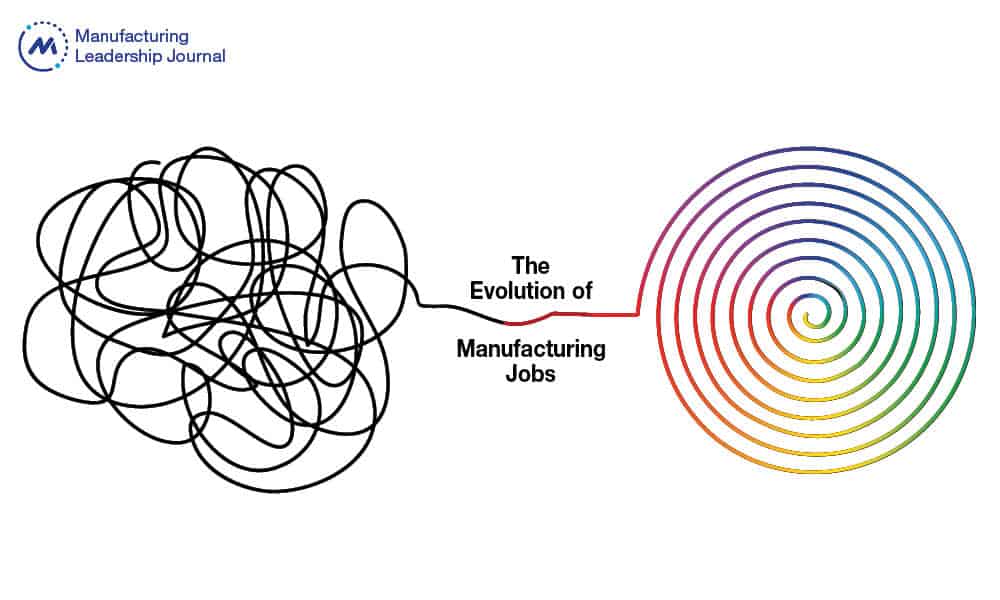The Evolution of Manufacturing Jobs

Networking technology is driving transformation and empowering leaders through both growth and disruption.

TAKEAWAYS:
● Digital transformation and the evolution of manufacturing jobs rely upon enhanced connectivity.
● The workforce evolution isn’t just about how jobs are done but also who is doing the jobs.
● Business leaders can find success through employee training and digital transformation that leverages networking technology.
This is a different manufacturing industry than even a decade ago. What got the industry here today, will not get it where it needs to be tomorrow.
Manufacturing leaders are grappling with how to adapt and grow in an environment that is undergoing constant disruption by advances in technology, globalization, and shifting customer demands.
The Evolution of Manufacturing Jobs
In the past, manufacturing jobs primarily involved manual labor and repetitive tasks on assembly lines. Today, these jobs are evolving to include a higher degree of automation, digitization, and skilled labor. This same transformation is happening in other industries and even at AT&T.
What are the factors contributing to this radical sea change?
- Automation and robotics: The rise of automation and robotics in manufacturing has led to a reduction in the need for manual labor. Tasks that were once performed by humans are now being handled by machines, allowing workers to focus on higher-value tasks that require specialized skills and expertise.
- Advanced manufacturing techniques: The adoption of advanced manufacturing techniques, such as additive manufacturing (3D printing) and computer numerical control (CNC) machining, has led to a greater need for skilled workers who can operate and maintain these sophisticated technologies.
- Digital transformation: The manufacturing industry’s digital transformation has created a growing demand for workers with expertise in data analytics, machine learning, and other digital skills. As manufacturers increasingly rely on data-driven decision-making, workers must be able to interpret and analyze complex data sets.
- Globalization: As companies continue to expand their operations across borders, there is an increasing need for workers who can navigate the complexities of global supply chains and communicate effectively with colleagues and partners around the world.
This evolution is not just about how jobs are done. It is also about who is doing them. The shift toward some jobs requiring higher levels of education and less physical strain has helped create more opportunities for women in the industry.
“Although men still hold the majority (67.9%) of U.S. manufacturing jobs, the Census Bureau’s Job-to-Job (J2J) Flows Explorer shows that from 2010 until the pandemic struck in 2020, the share of women in manufacturing jobs rose in every working-age category,” according to an October 2022 U.S. Department of Commerce report. “In 2021, the data show the numbers going back up to pre-Covid levels. Certain age groups show an even higher spike than before the pandemic. For example, 8.6% of the people who went into manufacturing jobs were women ages 55 to 64 before the pandemic but increased to 9.1% in 2021.”

“Advanced connectivity is critical for driving innovation, improving efficiency, and enabling new ways of working”
While there has been progress in getting more women in the industry, there is more work to be done including taking a proactive approach to providing and seeking out opportunities for women and encouraging women to lean in to be comfortable while not placing artificial limits on others. And once a woman has her foot in the door, she should send the elevator back down for others who are waiting in the lobby for their opportunity.
The Role of Enhanced Connectivity
Enhanced connectivity, enabled by technologies like 5G and fiber-optic networks, is playing a crucial role in this manufacturing jobs evolution and the industry’s digital transformation. The increased speed, bandwidth, and reliability of these advanced networking solutions provide numerous benefits for manufacturers, including:
- Real-time data exchange
- Accelerated decision-making
- Improved collaboration
- Support for IoT and Industry 4.0
- Remote monitoring and control
- Enhanced supply chain visibility
- Support for remote work and distributed teams
- Scalability and flexibility
- Reduced latency
By embracing enhanced connectivity solutions like 5G and fiber-optic networks, manufacturers can unlock a range of benefits that help them adapt to the changing nature of manufacturing jobs and stay competitive in the digital age. This advanced connectivity is critical for driving innovation, improving efficiency, and enabling new ways of working in the manufacturing industry.
More than just 5G and Fiber
Other networking technologies, from IoT to cybersecurity, are also playing crucial roles.
IoT devices and sensors connected via networking technology collect real-time data on production processes, equipment, and environmental conditions. This data enables manufacturers to monitor their operations closely, identify potential issues, and optimize their processes for greater efficiency and productivity.
Networking technology has facilitated the widespread adoption of cloud computing in the manufacturing industry. Cloud-based platforms and services allow companies to store, process, and analyze vast amounts of data, streamline their operations, and enhance collaboration among employees and external partners.
As manufacturing operations generate massive amounts of data, edge computing has emerged as a valuable solution to process and analyze this data close to its source. Networking technology enables edge computing by connecting devices and systems at the edge of the network, reducing latency, and ensuring real-time analysis.

“Leaders must be proactive in adapting strategies and practices to this new reality and workforce”
With the increasing need for connectivity by manufacturing operations, the importance of robust cybersecurity measures has become paramount. Networking technology plays a critical role in securing data and communication channels, protecting businesses from potential cyber threats and ensuring the confidentiality, integrity, and availability of information.
Meanwhile, networking technology has revolutionized supply chain management in the manufacturing industry by facilitating real-time communication, data exchange, and collaboration between various stakeholders, such as suppliers, logistics providers, and customers. This enhanced connectivity allows companies to optimize their supply chains, minimize disruptions, and respond rapidly to changes in demand.
How Business Leaders Can Respond
That is a lot of disruption! It is exciting, but it also creates unique challenges that previous manufacturing leaders never encountered. Today’s leaders cannot be laggards. They must be proactive in adapting strategies and practices to this new reality and workforce. Here are some steps they can take:
- Invest in employee training and development: As the nature of manufacturing jobs evolves, it is essential for companies to invest in ongoing training and development programs that help workers acquire the necessary skills and expertise. This includes providing access to online courses, workshops, and industry conferences focused on networking technology, automation, and digital skills.
- Embrace digital transformation: Business leaders must recognize the importance of digital transformation and embrace the adoption of advanced technologies, such as IoT, cloud computing, and edge computing. This involves not only investing in new technologies but also developing a culture of innovation and continuous improvement within the organization.
- Foster a culture of open communication: Encouraging communication and collaboration across the organization is crucial for adapting to the evolving nature of manufacturing jobs. Leaders should provide employees with the tools and platforms they need to share ideas, ask questions, and collaborate with their peers, both internally and externally.
- Leverage data-driven decision-making: As manufacturing becomes increasingly data-driven, leaders must learn to leverage data and analytics to make more informed decisions. This involves investing in data analytics tools and platforms, as well as training employees to use them effectively.
- Prioritize cybersecurity: With the increasing reliance on networking technology and connectivity, it is crucial for business leaders to prioritize cybersecurity. This includes implementing robust security measures, such as firewalls, intrusion detection systems, and encryption, as well as educating employees about cybersecurity best practices.
- Build strong relationships with external partners: In a globalized economy, it is essential for manufacturers to build strong relationships with external partners, such as suppliers, logistics providers, and customers. Networking technology can help facilitate these relationships by enabling real-time collaboration and information sharing.
- Prepare for the future of work: The manufacturing industry is continually evolving, and business leaders must be prepared for future changes to the nature of work. This includes staying informed about emerging trends and technologies, such as advancements in networking technology, as well as being open to new ways of working and managing talent.
In conclusion, the evolution of manufacturing jobs – driven by technological advancements, globalization, and changing customer demands – is significantly impacting the industry. Networking technology is at the heart of this transformation, enabling businesses to adapt and thrive in this new environment.
By investing in employee training and development, embracing digital transformation, and leveraging the many benefits of networking technology, business leaders can position their organizations for success in manufacturing’s future. It is essential for leaders to stay informed about emerging trends and technologies, be prepared to adapt their strategies and practices, and seize the opportunities presented by this rapidly changing landscape. M
About the author:

Andrea (Ande) Hazard is Vice President, Manufacturing and Transportation Solutions for AT&T Business where she leads a team of sales professionals, technical architects and engineers delivering AT&T products, services and global solutions to enterprise clients. Her organization focuses on the manufacturing, transportation, logistics and consumer packaged goods industries, ensuring an integrated, enterprise-wide customer experience for their clients.